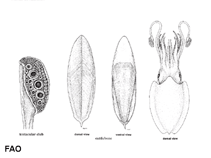Rhombosepion orbignyanum (Férussac, 1826)
Pink cuttlefish
Classification / Names Common names | Synonyms | CoL | ITIS | WoRMS
Cephalopoda | Sepiida | Sepiidae
Environment: milieu / climate zone / depth range / distribution range Ecology
Demersal; brackish; depth range 15 - 570 m (Ref. 1695), usually 50 - 250 m (Ref. 1695). Subtropical; 55°N - 17°S, 22°W - 36°E (Ref. 107081)
Distribution Countries | FAO areas | Ecosystems | Occurrences | Introductions
Eastern Atlantic and the Mediterranean: from Irish Sea to southern Angola.
Length at first maturity / Size / Weight / Age
Maturity: Lm 7.0, range 4 - ? cm Max length : 9.6 cm ML male/unsexed; (Ref. 1695); 12 cm ML (female)
Short description Morphology
Mantle length at first sexual maturity in West Africa: 4.0-5.0 cm (male); 7.0 cm. Mantle length at first sexual maturity in western Mediterranean: 5.0 cm (males); 7.8 cm (females; Ref. 275).
Life cycle and mating behavior Maturity | Reproduction | Spawning | Eggs | Fecundity | Larvae
Members of the class Cephalopoda are gonochoric. Male and female adults usually die shortly after spawning and brooding, respectively. Mating behavior: Males perform various displays to attract potential females for copulation. During copulation, male grasp the female and inserts the hectocotylus into the female's mantle cavity where fertilization usually occurs. Life cycle: Embryos hatch into planktonic stage and live for some time before they grow larger and take up a benthic existence as adults.
Main reference
References | Coordinator | Collaborators
Jereb, P. and C.F.E. Roper (eds.). 2005. (Ref. 1695)
IUCN Red List Status (Ref. 130435: Version 2024-1)
Data deficient (DD) ; Date assessed: 15 March 2009
CITES status (Ref. 108899)
Not Evaluated
CMS (Ref. 116361)
Not Evaluated
Threat to humans
Human uses
Fisheries: commercial
| FishSource |
Tools
More information
Trophic Ecology
Ecology
Population dynamics
Life cycle
Distribution
Human Related
Aquaculture profile
Stamps, Coins Misc.
Stamps, Coins Misc.
Outreach
References
Internet sources
BHL | BOLD Systems | CISTI | DiscoverLife | FAO(Publication : search) | Fishipedia | GenBank (genome, nucleotide) | GloBI | Gomexsi | Google Books | Google Scholar | Google | PubMed | Tree of Life | Wikipedia (Go, Search) | Zoological Record
Estimates based on models
Preferred temperature
(Ref. 115969): 11.2 - 18.2, mean 14.4 (based on 347 cells).



